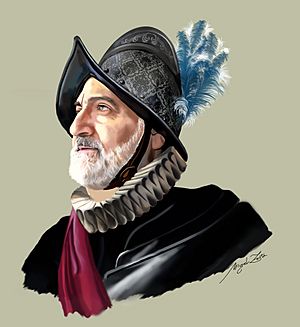García de Silva Figueroa facts for kids
Don García de Silva Figueroa (born December 29, 1550 – died July 22, 1624) was an important Spanish diplomat. A diplomat is someone who represents their country in other nations. He was the first Western traveler to correctly identify the ruins of Takht-e Jamshid in Persia (modern-day Iran). He realized these ruins were actually Persepolis, the ancient capital of the Achaemenid Empire. Persepolis was one of the greatest cities of the ancient world.
Contents
Life and Important Work
Early Life and Career
García de Silva Figueroa was born in Zafra, a town in the Spanish province of Badajoz. He started his career in the military, serving in Flanders. Later, he became the governor of Badajoz.
Ambassador to Persia
In 1612, King Philip III of both Spain and Portugal chose De Silva for a very important job. He was to be the ambassador to the court of Shah Abbas, the ruler of the Safavid Empire in Persia.
Before reaching Persia, De Silva faced some delays. He was held in Goa because he had strong disagreements with the Portuguese viceroy there. A viceroy was like a governor who ruled a colony for the king. Because of this, De Silva did not arrive in Persia until October 1617.
Diplomatic Missions
De Silva's visit was a return gesture from King Philip III. Shah Abbas had previously sent his own ambassadors to Spain. These included the Englishman Robert Shirley and the Persian Dengiz Beg Rumlu, along with the Portuguese friar Antonio de Gouvea.
During his time in Persia, De Silva handled many important diplomatic tasks. One key goal was to form an alliance against the Ottoman Empire. The Ottomans were a powerful enemy of Persia, Portugal, and Spain.
Exploring Persia
De Silva traveled widely across Persia. He visited famous cities like Shiraz, Qom, and Isfahan. He made sure to see the ancient ruins of Persepolis. He wrote a very detailed letter to Alfonso de la Cueva, marqués de Bedmar, describing the amazing sights of Persepolis. This letter greatly impressed scholars in Europe. It was quickly translated into Latin and English. In Isfahan, De Silva met another famous traveler, the Italian Pietro della Valle.
His Writings and Collections
During his travels, De Silva collected many rare art objects. He planned to take these treasures back to Spain when his mission ended in 1619. He wrote a complete account of his journeys. The book was titled Totius legationis suae et Indicarum rerum Persidisque commentarii. A Dutch scholar, Abraham de Wicquefort, translated it into French in 1667. The original handwritten book is kept today in the National Library of Spain in Madrid. It was first fully published in 1903.
De Silva's writings are full of detailed information. They describe the geography, history, and culture of Persia. He wrote about many things, like the funeral customs of the Zoroastrians. He also described the sport of organized bull-fighting in Persian towns. He even wrote about how date palms were grown in southern Iran. His book is now seen as a very important historical record of early 17th-century Persia.
Journey Home and Death
De Silva's trip back to Spain was difficult and full of problems. He reached Ormuz and Goa in 1621. Then, in 1622, he arrived in Mozambique. However, it was too late in the season to sail around the Cape of Good Hope. He had to go back to Goa again. After a long wait, he was finally able to sail for Spain. Sadly, he died at sea before reaching his home country.
Fictional Character
García de Silva y Figueroa is the main character in a horror and mystery story. The story is called Denn die Toten segeln schnell ("Because the dead sail quickly"). It was written by the Spanish author Salomé Guadalupe Ingelmo. This text is part of a collection called Lo Siniestro.
Portraits
In 2017, the Spanish painter Alejandro Cabeza created a portrait of García de Silva. He used oil paints on canvas. The artist was inspired by the physical description of the ambassador that Pietro Della Valle had written. Cabeza's painting carefully shows what García de Silva might have looked like.
See also
 In Spanish: García de Silva y Figueroa para niños
In Spanish: García de Silva y Figueroa para niños



